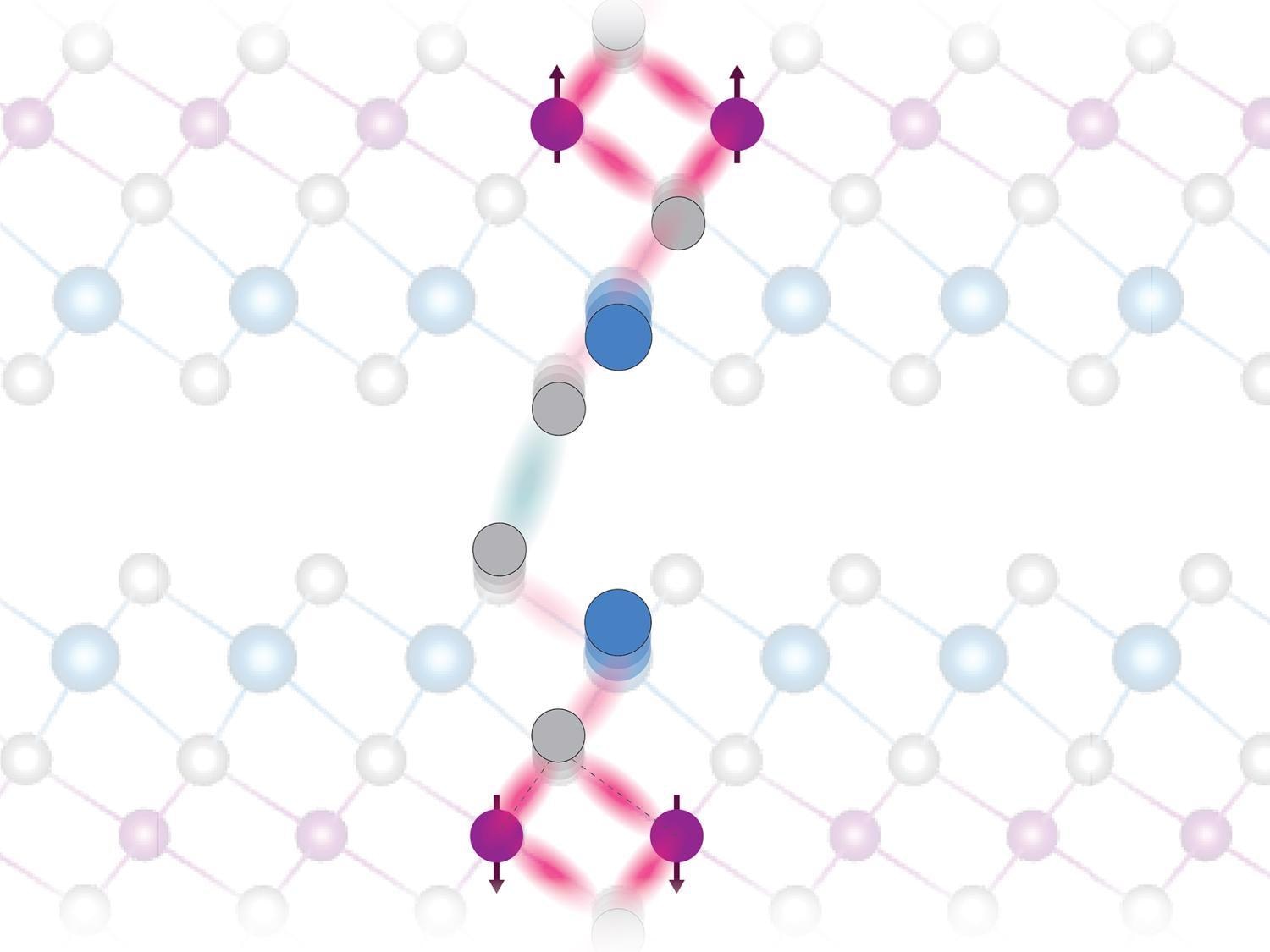Reviewed by Alex SmithApr 13 2022
One of the oldest technological concepts known to man — magnetism is at the cutting edge of advanced materials that could facilitate next-generation quantum computers and lossless electronics.
 This illustration depicts atomic vibrations, or phonons, in the crystalline lattice structure of manganese bismuth telluride. The discovery that these vibrations can tune weak magnetic bonds between the layers of this 2D material could unlock special properties and pave the way for its use in next-generation electronic devices Image Credit: Penn State University. All Rights Reserved.
This illustration depicts atomic vibrations, or phonons, in the crystalline lattice structure of manganese bismuth telluride. The discovery that these vibrations can tune weak magnetic bonds between the layers of this 2D material could unlock special properties and pave the way for its use in next-generation electronic devices Image Credit: Penn State University. All Rights Reserved.
Scientists directed by Penn State University (PSU) and the University of California, San Diego, have discovered a unique ‘knob’ to regulate the magnetic performance of one favorable quantum material, and the findings could create a path toward new, proficient and ultra-fast devices.
The unique quantum mechanical make-up of this material—manganese bismuth telluride—allows it to carry lossless electrical currents, something of tremendous technological interest. What makes this material especially intriguing is that this behavior is deeply connected to its magnetic properties. So, a knob to control magnetism in this material could also efficiently control these lossless currents.
Hari Padmanabhan, Study Lead and Graduate Student, Penn State University
Manganese bismuth telluride, a 2D material composed of atomically thin stacked layers, is an example of a topological insulator - unusual materials that concurrently can be conductors and insulators of electricity - the researchers stated.
Significantly, as this material is also magnetic, the currents transmitted through its edges could be lossless, meaning energy is not lost in the form of heat. Discovering a way to tweak the feeble magnetic bonds between the layers of the material could expose these utilities.
Minute vibrations of atoms, or phonons, in the material may be one approach to accomplishing this. The researchers reported the details of their work in the April 8th issue of the journal Nature Communications.
“Phonons are tiny atomic wiggles—atoms dancing together in various patterns, present in all materials,” Padmanabhan said. “We show that these atomic wiggles can potentially function as a knob to tune the magnetic bonding between the atomic layers in manganese bismuth telluride.”
The researchers at PSU examined the material using a method known as magneto-optical spectroscopy — focusing a laser beam onto a sample of the material and measuring the intensity and color of the reflected light, which holds information on the atomic vibrations. The researchers noted how the vibrations altered as they varied the magnetic field and temperature.
As they changed the magnetic field, the researchers noticed variations in the intensity of the phonons. This effect is because of the phonons impacting the feeble inter-layer magnetic bonding, the researchers explained.
Using temperature and magnetic field to vary the magnetic structure of the material—much like using a refrigerator magnet to magnetize a needle compass—we found that the phonon intensities were strongly correlated with the magnetic structure. Pairing these findings with theoretical calculations, we inferred that these atomic vibrations modify the magnetic bonding across layers of this material.
Maxwell Poore, Study Co-Author and Graduate Student, UC San Diego
Researchers at UC San Diego carried out experiments to monitor these atomic vibrations instantaneously. The phonons vacillate quicker than a trillion times a second, many times quicker than contemporary computer chips, the researchers stated. A 3.5 gigahertz computer processor, for instance, works at a frequency of 3.5 billion times per second.
What was beautiful about this result was that we studied the material using different complementary experimental methods at different institutions and they all remarkably converged to the same picture.
Peter Kim, Study Co-Author and Graduate Student, UC San Diego
More research is required to be able to use the magnetic knob, the researchers stated. But if that can be accomplished, it could pave the way to ultra-fast devices that can competently and reversibly regulate lossless currents.
“A major challenge in making faster, more powerful electronic processors is that they heat up,” said Venkatraman Gopalan, professor of materials science and engineering and physics at PSU, Padmanabhan’s former adviser, and the study’s co-author. “Heating wastes energy. If we could find efficient ways to control materials that host lossless currents, that would potentially allow us to deploy them in future energy-efficient electronic devices.”
Other PSU scientists were Vladimir Stoica, associate research professor, Huaiyu "Hugo" Wang, graduate student, and Maxwell Wetherington, staff scientist, Materials Research Institute and Department of Materials Science and Engineering; and Seng Huat Lee, assistant research professor, and Zhiqiang Mao, professor, 2D Crystal Consortium and Department of Physics.
Also contributing to the study were James Rondinelli, professor, Danilo Puggioni, research assistant professor, Mingqiang Gu, postdoctoral scholar, and Nathan Koocher, graduate student, Northwestern University; Richard Averitt, professor, University of California, San Diego; Richard Schaller, staff scientist, Argonne National Laboratory; Xijie Wang, Xiaozhe Shen, and Alexander Reid, staff scientists, SLAC National Accelerator Laboratory; and Aaron Lindenberg, associate professor, Stanford University.
This research received funding from the U.S. Department of Energy, Army Research Office, and National Science Foundation.
Journal Reference:
Padmanabhan, H., et al. (2022) Interlayer magnetophononic coupling in MnBi2Te4. Nature Communications. doi.org/10.1038/s41467-022-29545-5.